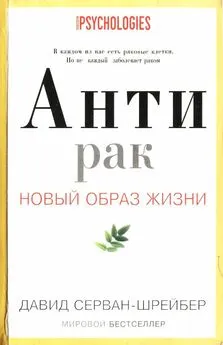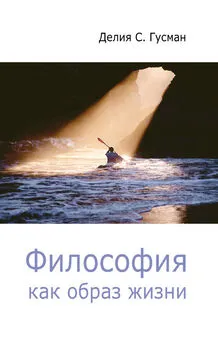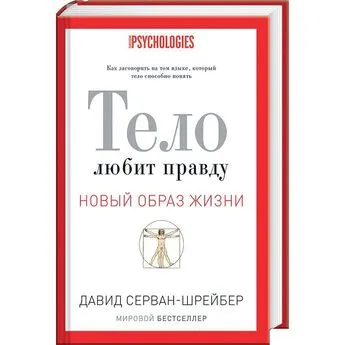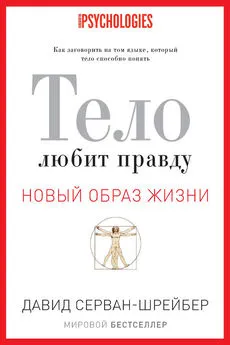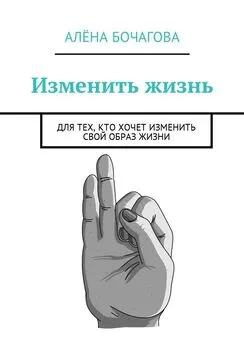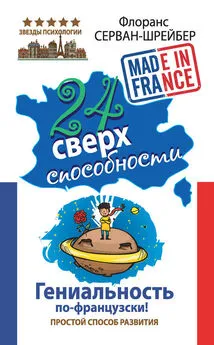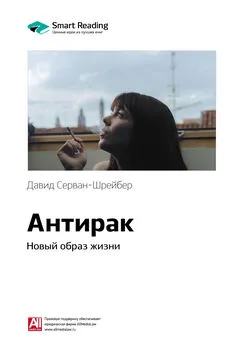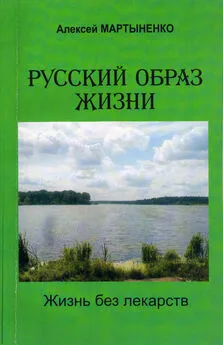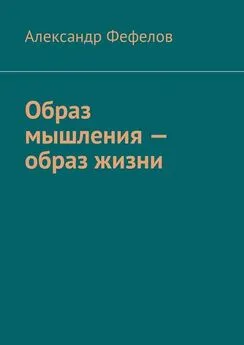Давид Серван-Шрейбер - Антирак. Новый образ жизни
- Название:Антирак. Новый образ жизни
- Автор:
- Жанр:
- Издательство:РИПОЛ классик
- Год:2010
- Город:Москва
- ISBN:978-5-386-02111-5
- Рейтинг:
- Избранное:Добавить в избранное
-
Отзывы:
-
Ваша оценка:
Давид Серван-Шрейбер - Антирак. Новый образ жизни краткое содержание
Антирак. Новый образ жизни - читать онлайн бесплатно ознакомительный отрывок
Интервал:
Закладка:
30. Mantovani, A., B. Bottazzi, F. Colotta, et al., “The Origin and Function of Tumor-Associated Macrophages,” Immunology Today 13, no. 7 (1992): 265-70.
31. Baxevanis, C. N., G. J. Reclos, A. D. Gritzapis, et al., “Elevated Prostaglandin E2 Production by Monocytes Is Responsible for the Depressed Levels of Natural Killer and Lymphokine-Activated Killer Cell Function in Patients with Breast Cancer,” Cancer 72, no. 2 (1993): 491-501.
32. Marx, J., “Cancer Research: Inflammation and Cancer: The Link Grows Stronger,” Science 306 (2004): 5698-966.
33. Wallace, J., “Nutritional and Botanical Modulation of the Inflammatory Cascade—Eicosanoids, Cyclooxygenases, and Lipoxygenases—as an Adjunct in Cancer Therapy,” Integrative Cancer Therapies 1, no. 1 (2002): 7-37.
34. Crumley, A. B. C., D. C. McMillan, M. McKernan, et al., “Evaluation of an Inflammation-Based Prognostic Score in Patients with Inoperable Gastro-oesophageal Cancer,” British Journal of Cancer 94, no. 5 (2006): 637-41.
35. Al Murri, A. M., J. M. S. Bartlett, P. A. Canney, et al., “Evaluation of an Inflammation-Based Prognostic Score (GPS) in Patients with Metastatic Breast Cancer,” British Journal of Cancer 94, no. 2 (2006): 227-30.
36. Forrest, L. M., D. C. McMillan, C. S. McArdle, et al., “Comparison of an Inflammation-Based Prognostic Score (GPS) with Performance Status (ECOG) in Patients Receiving Platinum-Based Chemotherapy for Inoperable Non-Small-Cell Lung Cancer,” British Journal of Cancer 90, no. 9 (2004): 1704-6.
37. Harris, R. E., S. Kasbari, and W. B. Farrar, “Prospective Study of Nonsteroidal Anti-inflammatory Drugs and Breast Cancer,” Oncology Reports 6, no. 1 (1999): 71-73.
38. Nelson, J. E., and R. E. Harris, “Inverse Association of Prostate Cancer and Non-steroidal Anti-Inflammatory Drugs (NSAIDs): Results of a Case-Control Study,” Oncology Reports 7, no. 1 (2000): 169-70.
39. Thun, M. J., “NSAID Use and Decreased Risk of Gastrointestinal Cancers,” Gastroenterology Clinics of North America 25, no. 2 (1996): 333-48.
40. Karin, M., and F. R. Greten, “NF-kappaB: Linking Inflammation and Immunity to Cancer Development and Progression,” Nature Reviews Immunology 5, no. 10 (2005): 749-59.
41. Marx, “Cancer Research.”
42. Ibid.
43. Calcagni, E., and I. Elenkov, “Stress System Activity, Innate and T Helper Cytokines, and Susceptibility to Immune-Related Diseases,” Annals of the New York Academy of Sciences 1069 (2006): 62-76.
44. Glaser, R., “Stress-Associated Immune Dysregulation and Its Importance for Human Health: A Personal History of Psychoneuroimmunology,” Brain, Behavior, & Immunity 19, no. 1 (2005): 3-11.
45. Beevor, A., Stalingrad: The Fateful Siege: 1942-1943 (New York: Penguin Group, 1998).
46. Folkman, J., “Fighting Cancer by Attacking Its Blood Supply,” Scientific American , September 1996, 150-54.
47. Folkman, J., “Tumor Angiogenesis: Therapeutic Implications,” New England Journal of Medicine 285, no. 21 (1971): 1182-86.
48. Ibid.
49. “Cancer Warrior,” NOVA Online, 2001. (Accessed November 2, 2006, at
http://www.pbs.org/wgbh/nova/cancer/program.html.)
50. O’Reilly, M. S., L. Holmgren, Y. Shing, et al., “Angiostatin: A Novel Angiogenesis Inhibitor That Mediates the Suppression of Metastases by a Lewis Lung Carcinoma,” Cell 79, no. 2 (1994): 315-28.
51. O’Reilly, M. S., L. Holmgren, C. Chen, et al., “Angiostatin Induces and Sustains Dormancy of Human Primary Tumors in Mice,” Nature Medicine 2, no. 6 (1996): 689-92.
52. Rose, D. P., and J. M. Connolly, “Regulation of Tumor Angiogenesis by Dietary Fatty Acids and Eicosanoids,” Nutrition and Cancer 37, no. 2 (2000): 119-27.
53. Béliveau, R., and D. Gingras, Foods That Fight Cancer (New York: McClelland & Stewart Ltd., 2006).
54. Béliveau, R., and D. Gingras, “Green Tea: Prevention and Treatment of Cancer by Nutraceuticals,” Lancet 364, no. 9439 (2004): 1021-22.
55. Rose and Connolly, “Regulation of Tumor Angiogenesis by Dietary Fatty Acids and Eicosanoids.”
56. Ziche, M., J. Jones, and P. M. Gullino, “Role of Prostaglandin E1 and Copper in Angiogenesis,” Journal of the National Cancer Institute 69, no. 2 (1982): 475-82.
Глава 6
1. Dinse, G. E., D. M. Umbach, A. J. Sasco, et al., “Unexplained Increases in Cancer Incidence in the United States from 1975 to 1994: Possible Sentinel Health Indicators?” Annual Review of Public Health 20 (1999): 173-209.
2. Institut de Veille Sanitaire, “Estimations Nationales: Tendances de l’Incidence et de la Mortalité par Cancer en France entre 1978 et 2000,” Ministère de la Santé, de la Famille et des Personnes Handicapées, 2002.
3. Surveillance Epidemiology and End Results (SEER). Cancer incidence public use database, 2006; see http://seer.cancer.gov/.
4. McGrath, K. G., “An Earlier Age of Breast Cancer Diagnosis Related to More Frequent Use of Antiperspirants/Deodorants and Underarm Shaving,” European Journal of Cancer Prevention 12, no. 6 (2003): 479-85.
5. Steliarova-Foucher, E., C. Stiller, P. Kaatsch, et al., “Geographical Patterns and Time Trends of Cancer Incidence and Survival Among Children and Adolescents in Europe Since the 1970s (the ACCIS Project): An Epidemiological Study,” Lancet 364, no. 9451 (2004): 2097-2105.
6. Post, P. N., D. Stockton, T. W. Davies, et al., “Striking Increase in Incidence of Prostate Cancer in Men Aged <60 Years Without Improvement in Prognosis,” British Journal of Cancer 79, no. 1 (1999): 13-17.
7. Institut de Veille Sanitaire, “Estimations Nationales.”
8. Ries, L. A. G., M. P. Eisner, C. L. Kosary, et al., “SEER Cancer Statistics Review 1975-2001,” National Cancer Institute, Bethesda, MD, 2004.
9. Institut de Veille Sanitaire, “Estimations Nationales.”
10. Ries, Eisner, Kosary, et al., “SEER Cancer Statistics Review 1975-2001.”
11. Ferlay, J., F. Bray, P. Piesci, et al., eds., WHO International Agency for Research on Cancer (IARC), IARC Cancer Epidemiology Database, Globocan 2000, Cancer Incidence, Mortality and Prevalence Worldwide (Lyon, France: IARC Press, 2000).
12. King, M-C., J. H. Marks, J. B. Mandell, et al., “Breast and Ovarian Cancer Risks Due to Inherited Mutations in BRCA1 and BRCA2,” Science 302, no. 5645 (2003): 643-46.
13. Institut de Veille Sanitaire, “Estimations Nationales.”
14. Rosenberg, C. E., The Cholera Years: The United States in 1832, 1849, and 1866 (Chicago, IL: University of Chicago Press, 1962).
15. Steingraber, S., Living Downstream: A Scientist’s Personal Investigation of Cancer and the Environment (New York: Vintage Books, 1998).
16. Davis, D., The Secret History of the War on Cancer (New York: Basic Books, 2007).
17. Waterhouse, J., C. Muir, K. Shamnugaratnam, et al., eds., Cancer Incidence in Five Continents, vol. IV (Lyon, France: IARC-W.H.O., 1982).
18. Sasco, A. J., “Migration and Cancer,” Revue de Médecine Interne 10, no. 4 (1989): 341-48.
19. Davis, The Secret History of the War on Cancer .
20. Waterhouse and Shamnugaratnam, Cancer Incidence in Five Continents.
21. Stewart, B. W., and P. Kleihues, eds., World Cancer Report (Lyon, France: W.H.O. IARC Press, 2003).
22. National Cancer Institute, Executive Summary of Cancer Etiology Think Tank (Bethesda, MD: National Cancer Institute, 2004).
23. Eaton, S. B., and M. Konner, “Paleolithic Nutrition: A Consideration of Its Nature and Current Implications,” New England Journal of Medicine 312, no. 5 (1985): 283-89.
24. Cordain, L., S. Eaton, A. Sebastian, et al., “Origins and Evolution of the Western Diet: Health Implications for the 21st Century,” American Journal of Clinical Nutrition 81, no. 2 (2005): 341-54.
25. Ibid.
26. Grothey, A., W. Voigt, C. Schober, et al., “The Role of Insulin-Like Growth Factor I and Its Receptor in Cell Growth, Transformation, Apoptosis, and Chemoresis tance in Solid Tumors,” Journal of Cancer Research & Clinical Oncology 125, no. 3-4 (1999): 166-73.
27. Long, L., R. Navab, and P. Brodt, “Regulation of the Mr 72,000 Type IV Collagenase by the Type I Insulin-Like Growth Factor Receptor,” Cancer Research 58m, no. 15 (1998): 3243-47.
28. Dunn, S. E., R. A. Hardman, F. W. Kari, et al., “Insulin-Like Growth Factor 1 (IGF-1) Alters Drug Sensitivity of HBL 100 Human Breast Cancer Cells by Inhibition of Apoptosis Induced by Diverse Anticancer Drugs,” Cancer Research 57, no. 13 (1997): 2687-93.
29. Cordain, L., S. Lindeberg, M. Hurtado, et al., “Acne Vulgaris: A Disease of Western Civilization,” Archives of Dermatology 138, no. 12 (2002): 1584-90.
30. Smith, R., N. Mann, A. Braue, et al., “The Effect of a Low Glycemic Load, High Protein Diet on Hormonal Markers of Acne,” Asia Pacific Journal of Clinical Nutrition 14 (supp.) (2005): S43.
31. Smith, R., N. Mann, A. Braue, et al., “Low Glycemic Load, High Protein Diet Lessens Facial Acne Severity,” Asia Pacific Journal of Clinical Nutrition 14 (supp.) (2005): S97.
32. Santisteban, G. A., J. T. Ely, E. E. Hamel, et al., “Glycemic Modulation of Tumor Tolerance in a Mouse Model of Breast Cancer,” Biochemical & Biopbysical Research Communications 132, no. 3 (1985): 1174-79.
33. Parkin, D., F. Bay, J. Ferlay, et al., “Global Cancer Statistics, 2002,” CA: A Cancer Journal for Clinicians 55 (2005): 74-108.
34. Weiderpass, E., G. Gridley, I. Persson, et al., “Risk of Endometrial and Breast Cancer in Patients with Diabetes Mellitus,” International Journal of Cancer 71, no. 3 (1997): 360-63.
35. Hankinson, S. E., W. C. Willett, G. A. Colditz, et al., “Circulating Concentrations of Insulin-Like Growth Factor-I and Risk of Breast Cancer,” Lancet 351, no. 9113 (1998): 1393-96.
36. Chan, J. M., M. J. Stampfer, E. Giovannucci, et al., “Plasma Insulin-Like Growth Factor-I and Prostate Cancer Risk: A Prospective Study,” Science 279, no. 5350 (1998): 563-66.
37. Chan, J. M., M. J. Stampfer, J. Ma, et al., “Insulin-Like Growth Factor-I (IGF-I) and IGF Binding Protein-3 as Predictors of Advanced-Stage Prostate Cancer,” Journal of the National Cancer Institute 94, no. 14 (2002): 1099-1106.
38. Michaud, D. S., S. Liu, E. Giovannucci, et al., “Dietary Sugar, Glycemic Load, and Pancreatic Cancer Risk in a Prospective Study,” Journal of the National Cancer Institute 94, no. 17 (2002): 1293-1300.
39. Michaud, D. S., C. S. Fuchs, S. Liu, et al., “Dietary Glycemic Load, Carbohydrate, Sugar, and Colorectal Cancer Risk in Men and Women,” Cancer Epidemiology, Biomarkers & Prevention 14, no. 1 (2005): 138-47.
40. Franceschi, S., L. Dal Maso, L. Augustin, et al., “Dietary Glycemic Load and Colorectal Cancer Risk,” Annals of Oncology 12, no. 2 (2001): 173-78.
41. Augustin, L. S. A., J. Polesel, C. Bosetti, et al., “Dietary Glycemic Index, Glycemic Load and Ovarian Cancer Risk: A Case-Control Study in Italy,” Annals of Oncology 14, no. 1 (2003): 78-84.
42. Gunter, M. J., et al., “Insulin, Insulin-Like Growth Factor-I, and Risk of Breast Cancer in Postmenopausal Women,” Journal of the National Cancer Institute 101 (2009): 48-60.
Читать дальшеИнтервал:
Закладка:
